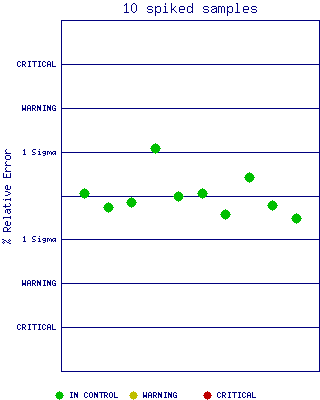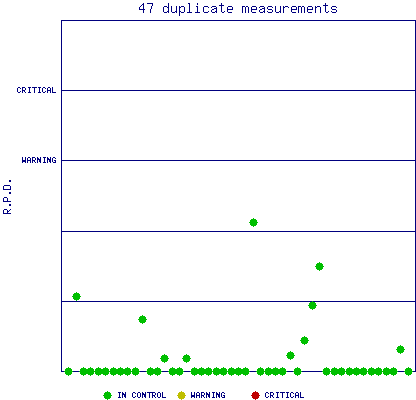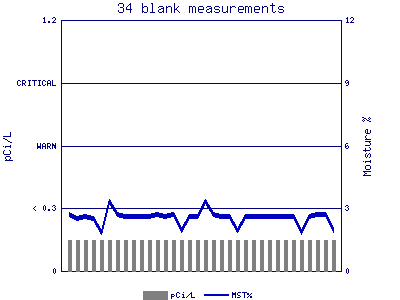4. Quality Control for Radon Testing
School testing projects need to include quality assurance procedures that will ensure that the testing is meaningful and test results are reliable. It is advised that you develop a quality assurance plan prior to initiating the testing project. If you need assistance in developing a plan, a template is available from
Air Chek. The required quality control measures include blanks, duplicates, and spikes. These measurements should be made in a way that we at
Air Chek do not know that they are a part of the quality assurance process until after the lab analysis is complete.
Field Blanks
Field blanks are radon test kits that are not exposed to room air and are used to determine whether the test kits have been contaminated during storage. Field blanks are opened and immediately re-sealed to keep room air from infiltrating the test kit. Blanks are required to be used at a rate of 5% of the rooms tested or 1 out of every 20 rooms. While radon cannot travel through the plastic and enter the charcoal during storage, humidity in the storage area may be able to find a pathway through tiny leaks in the packaging. Excessive moisture finding its way into the charcoal can reduce the effectiveness of the test kits.
Blanks should be pulled from the first box of test kits immediately upon receipt. These blanks will be used to set a baseline for the amount of moisture contained in the new test kits. Since it is also recommended that you pull kits from the first box for immediate spiking (see below), the initial blanks pulled from the first box of kits are held in your office until the spikes are returned to you from the radon chamber (spiking) facility. Assessing the moisture content of blanks over the course of the testing project can be used to ensure that the storage of the kits is not jeopardizing the quality of the test kits.
Duplicates
Duplicates should be performed at a rate 10% of all non QC tests. Duplicates are two radon tests that are hung side-by-side (6-12 inches apart) and are used to determine the reproducibility of the test kit and laboratory analysis. The EPA school testing guidance recommends assessing duplicates for rooms that have more than 4.0 pCi/L when the two results are averaged. Appendix E of the EPA School Guidance contains specific guidance and calculations that are to be used to assess quality control measurements.
The standard formula for the grading of duplicate measurements is as follows:
RPD = abs(D1-D2) / avg(D1+D2) x 100%
where:
RPD = Relative Percent Difference
D1 = measured value of the first duplicate
D2 = measured value of the second duplicate
ABS = absolute value of D1-D2
AVG = average value of D1 and D2
* ABS() and AVG() are standard functions in Excel
Spikes
Spiked measurements are exposed in a radon chamber to a known amount of radon and then returned to the laboratory without the laboratory’s knowledge. Air Chek’s calibration is performed using the Bowser-MornerRadon Reference Laboratory, therefore we recommend only the Bowser-Morner spiking services to make sure that spikes are done in an facility that has no conflict-of-interest. Some spiking facilities are competitors to Air Chek and the perception of a conflict should be avoided. Bowser-Morner is the industry’s standard radon chamber and they participate in intercomparison exercises with the US EPA’s Las Vegas radon laboratory. Once the laboratory analysis has been performed you should assess the accuracy of the measurements.
The standard formula for the grading of spikes is as follows:
IRE = (MV – TV)/TV x 100%
where:
IRE = Individual Relative Error
MV = measured value of the spiked sample
TV = target value of the radon chamber
All IRE for spiked samples should be less than or equal to 25%. Spikes must be performed at a rate of 3% of the samples used for the school project, with a minimum of 3 per year and a maximum of 6 per month.
It is recommended that you perform spikes immediately upon receipt of the test devices at the same time you pull samples for the initial Field Blanks. You will submit the samples to be spiked to Bowser-Morner. They will expose the kits to a known amount of radon and will return the samples to you when they are removed from the chamber. You will need to report the actual dates and times that kits were placed into and removed from the radon chamber so that the samples can be analyzed in our laboratory using the actual exposure dates. For the initial blanks, it is recommended that you use the same dates and times as used for the spiked samples. We recommend that you create a false school or building name for the initial blanks and spikes so that the data can be combined to look like actual testing data. Once the logs are complete, you will return the samples to the laboratory in the same package. It is recommended that you make notations on the permanent copy of the data logs that these were QA samples and make sure you distinguish which ones were blanks and which were spikes.
You will keep all quality control measurement records in your files so that they can be assessed and summarized at the end of the testing project. By performing quality control measurements on new kits and periodically throughout the testing project and again at the end of the project, you will have a series of measurement that can be used to identify potential problems or to document the accuracy and reliability of the test results.
Contact Bowser-Morner as early in the project as possible to determine the most convenient spiking schedule and costs. You can reach Pam Kilburn at Bowser-Morner by calling (937) 236-8805 x259.
Sample Charts
 This sample spike chart displays the IRE threshold of spiked samples. The IRE for Tests above 4 pCi/L and tests for between 2 and 4 pCi/L is automatically scaled to the appropriate levels so that only need to look to see if anything has exceeded warning or critical levels.
This sample spike chart displays the IRE threshold of spiked samples. The IRE for Tests above 4 pCi/L and tests for between 2 and 4 pCi/L is automatically scaled to the appropriate levels so that only need to look to see if anything has exceeded warning or critical levels.
 This sample duplicate chart displays the RPD of duplicate measurements. The RPD for Tests above 4 pCi/L and tests for between 2 and 4 pCi/L is automatically scaled to the appropriate levels so that you only need to look to see if anything has exceeded warning or critical levels.
This sample duplicate chart displays the RPD of duplicate measurements. The RPD for Tests above 4 pCi/L and tests for between 2 and 4 pCi/L is automatically scaled to the appropriate levels so that you only need to look to see if anything has exceeded warning or critical levels.
 This sample blank chart demonstrates the readings of your blank samples as well as the measured percentage moisture of the tests. Tracking the moisture allows you to determine if storage conditions may be affecting the efficacy of the test devices.
This sample blank chart demonstrates the readings of your blank samples as well as the measured percentage moisture of the tests. Tracking the moisture allows you to determine if storage conditions may be affecting the efficacy of the test devices.



 This sample spike chart displays the IRE threshold of spiked samples. The IRE for Tests above 4 pCi/L and tests for between 2 and 4 pCi/L is automatically scaled to the appropriate levels so that only need to look to see if anything has exceeded warning or critical levels.
This sample spike chart displays the IRE threshold of spiked samples. The IRE for Tests above 4 pCi/L and tests for between 2 and 4 pCi/L is automatically scaled to the appropriate levels so that only need to look to see if anything has exceeded warning or critical levels. This sample duplicate chart displays the RPD of duplicate measurements. The RPD for Tests above 4 pCi/L and tests for between 2 and 4 pCi/L is automatically scaled to the appropriate levels so that you only need to look to see if anything has exceeded warning or critical levels.
This sample duplicate chart displays the RPD of duplicate measurements. The RPD for Tests above 4 pCi/L and tests for between 2 and 4 pCi/L is automatically scaled to the appropriate levels so that you only need to look to see if anything has exceeded warning or critical levels. This sample blank chart demonstrates the readings of your blank samples as well as the measured percentage moisture of the tests. Tracking the moisture allows you to determine if storage conditions may be affecting the efficacy of the test devices.
This sample blank chart demonstrates the readings of your blank samples as well as the measured percentage moisture of the tests. Tracking the moisture allows you to determine if storage conditions may be affecting the efficacy of the test devices.
